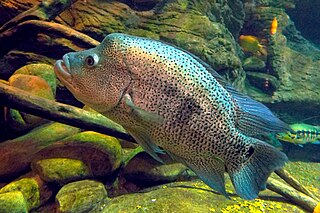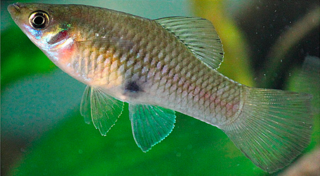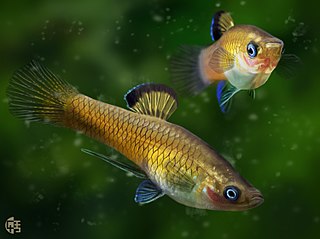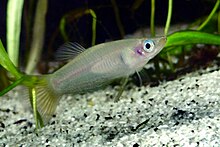
Parachromis managuensis is a large species of cichlid native to freshwater habitats in Central America, where it is found from Honduras to Costa Rica. The binomial name refers to Lake Managua in Nicaragua, from which the holotype was obtained. It is a food fish and is also found in the aquarium trade where it is variously known as the jaguar cichlid, managuense cichlid, managua cichlid, guapote tigre, Aztec cichlid, spotted guapote and jaguar guapote. In Costa Rica it is known as the guapote tigre.
Maquenque Wildlife Refuge, is a protected area in Costa Rica, managed under the Arenal Huetar Norte Conservation Area, it was created in 2005 by decree 32405-MINAE.

Pelvicachromis pulcher is a freshwater fish of the cichlid family, endemic to Nigeria and Cameroon. It is popular amongst aquarium hobbyists, and is most commonly sold under the name kribensis, although it has other common names, including various derivatives and color morphs of the kribensis: krib, common krib, red krib, super-red krib and rainbow krib, along with rainbow cichlid and purple cichlid.

The eyespot rasbora is a small fish belonging to the Family Cyprinidae, subfamily Danioninae, which is known by the common names of ocellated rasbora, hi-spot rasbora, and eye-spot rasbora, an allusion to the marking situated upon the dorsal fin. This small fish is a popular aquarium fish, having been one of the species featured in the landmark textbook Exotic Aquarium Fishes by Dr William T. Innes. Its appearance in this work only occurs in later editions of the book, however, therefore the species is not subject to the same degree of aquarium domestication as the more familiar harlequin rasbora.

The bobo mullet, is a species of ray-finned fish of the mullet family Mugilidae. It is the only species in the genus Joturus, one of 17 mullet genera containing altogether about 80 species of ray-finned fish. It occurs in rivers, including brackish waters, in much of the Gulf of Mexico basin from Mexico as far south as Panama and the Caribbean coast of Colombia, as well as the West Indies and the United States state of Florida. The specific name honours the Cuban lexicographer and geographer Esteban Pichardo (1799-1879).

Hypsophrys nicaraguensis, the moga, is a species of cichlid native to the Atlantic slope of Central America, from Nicaragua to Costa Rica. The species is a popular aquarium fish and is traded under a variety of common names that include nickie, parrot cichlid, macaw cichlid, butterfly cichlid and nicaraguense. In Costa Rica it is known as a vieja.
Craugastor andi is a species of rain frog in the family Craugastoridae which has not been seen since 1990. It is found in the Caribbean drainage of Costa Rica in the mountains and hills of the Cordillera Central and the far northeastern Cordillera de Talamanca, and in extreme northwestern Panama. Frank and Ramus (1995) give it the vernacular name Atlantic robber frog. It is known locally in Spanish by the generic names, used for many species, of rana de hojarasca, ranita or sapito.
Pristimantis altae, also known as mountain robber frog, is a species of rain frog in the family Strabomantidae with a bright coral-coloured groin. It is found in Costa Rica and Panama.

Parachromis dovii, the guapote, rainbow bass, or wolf cichlid, is a species of cichlid native to Central America where it occurs in lakes, rivers and streams in Honduras, Nicaragua and Costa Rica. It is one of the largest cichlids, reaching up to 14 kg (31 lb) in weight and 80 cm (2.6 ft) long. A strongly predatory species, it mostly feeds on other fish. P. dovii is important to local commercial fisheries, sought after as a gamefish, and sometimes kept in aquariums.

Heterandria formosa is a species of livebearing fish within the family Poeciliidae. This is the same family that includes familiar aquarium fishes such as guppies and mollies. Heterandria formosa is not as commonly kept in aquaria as these species. Despite the common name "least killifish", it belongs to the family Poeciliidae and not to one of the killifish families. H. formosa is one of the smallest fish species; the 1991 Baensch Aquarium Atlas listed it as the 7th smallest fish in the world, and as of 2006 it remains the smallest fish species found in North America.

Platy is a common name of freshwater fish in the genus Xiphophorus that lack a "sword" at the bottom of their tails. Both species are livebearers, similar to other fish of the family Poeciliidae, such as the guppy and molly. Platies are native to the east coast of Central America and southern Mexico.

The pike topminnow, more commonly known as pike killifish and sometimes referred to as topminnow, is a species of poeciliid found from Mexico to Nicaragua. It has also been introduced to Florida, USA. It is the only known member of its genus. The pike topminnow was described in 1860 by Austrian ichthyologist Rudolf Kner, who gave the type locality as Belize, which is reflected in this species' specific name.

Phallichthys is a genus of poeciliids native to Central America. They are hardy fish which inhabit stagnant and slow-flowing waters, making them well-suited to fishkeeping.

The mountain mullet is a freshwater fish of the family Mugilidae. It can be found in North and South America, from North Carolina, Florida, Louisiana and Texas in the United States to Colombia and Venezuela, including the West Indies in the Antilles. It is the only species in the monotypic genus Dajaus.
Scolichthys greenwayi is a species of freshwater fish of the family Poeciliidae. It is found in flowing waters along the Rio Chixoy and Rio Salinas system in Alta Verapaz, Guatemala.

Limia melanogaster, the black-bellied or blue limia, is a poeciliid fish from Jamaica. It inhabits fast-flowing streams. It is a rare livebearer in modern fishkeeping.

Poecilia kykesis, also known as the Usumacinta molly, Petén molly, spiketail molly, or swordtail molly, is a poeciliid fish species native to the fresh and brackish waters of Mexico, Guatemala, and Belize. It belongs to the sailfin molly clade, with males exhibiting an enlarged dorsal fin. The species has a notably controversial naming history, with the former name, Poecilia petenensis, now referring to a short-finned molly species. It is a livebearer sometimes kept in aquaria.

Poecilia gillii, Gill's molly, is a herbivorous livebearer fish distributed throughout Central America. It is found in both moving and still water as well as in both freshwater and brackish habitats. Populations of this species differ in color, size, and morphology.

Phallichthys amates, the merry widow, is a livebearer fish from Central America, the largest and most widespread in its genus. Two subspecies range from Guatemala to Panama. Distinguishing features include the dark dorsal fin edge, a stripe through the eye, and an oversized male copulatory organ (gonopodium).

Phallichthys tico, the dwarf merry widow, is a livebearer fish from Central America. It lives in turbid, stagnant waters, often among aquatic plants, and feeds mainly on plant matter. It is sometimes kept in aquaria.
















